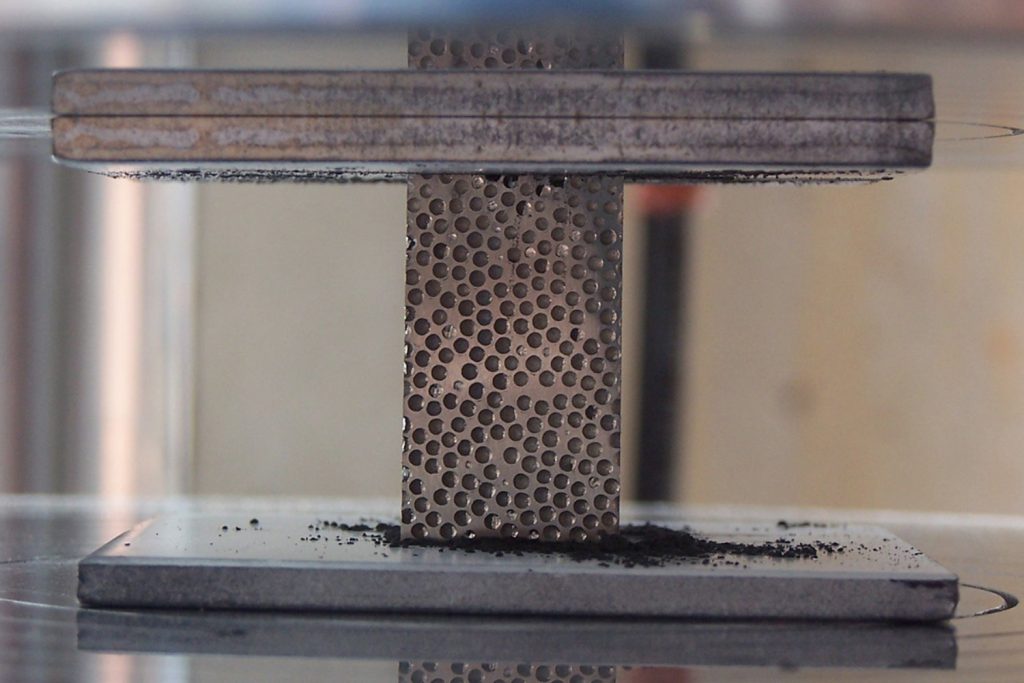How Super-Strong ‘Metal Foam’ Could Transform Space Travel and Defense – Gizmodo

What’s as strong as steel, as light as aluminum, and capable of withstanding ballistic impact, fire, and radiation? Metal foam.Over a decade ago, engineer Afsaneh Rabiei of North Carolina State University invented Composite Metal Foam (CMF)—a material made of hollow metal “bubbles” embedded in steel, titanium, aluminum, or other alloys. From air and space travel to defense, the exceptionally strong and lightweight material could have a variety of applications. After years of testing against ballistics, blasts, vibrations, radiation, and fire, Rabiei’s company, Advanced Materials Manufacturing, is officially ready for production.Though it wasn’t the first metal foam ever invented, Rabiei claims her CMF is the strongest. For example, in a 2019 study published in the journal Composite Structures, researchers demonstrated that vehicle armor made with steel-steel CMF (in which both the bubbles and the material they’re in are made from steel) stopped ball and armor-piercing .50 caliber rounds as efficiently as vehicle armor made with conventional steel, at less than half its weight.“The CMF armor was less than half the weight of the rolled homogeneous steel armor needed to achieve the same level of protection,” Rabiei, a co-author on the study, said in a North Carolina State University statement. “In other words, we were able to achieve significant weight savings—which benefits vehicle performance and fuel efficiency—without sacrificing protection.”Two years earlier, Rabiei and her colleagues found that CMF insulates against heat far better than a solid sheet of the same metal. As the team explained in a 2016 study published in the International Journal of Thermal Sciences, they exposed one side of a 2.5-inch by 2.5-inch by 0.75-inch (6.35 centimeter by 6.35 centimeter by 1.91 centimeter) thick piece of bulk stainless steel, as well as one side of a sample of CMF of the same size, to a 1,472-degree Fahrenheit (800-degree Celsius) flame. While the steel took four minutes to reach the same temperature, the CMF took eight.“The presence of air pockets inside CMF make it so effective at blocking heat, mainly because heat travels more slowly through air than through metal,” Rabiei explained in another university statement. That means CMF could protect heat-sensitive materials—whether hazardous chemicals or vehicles carrying astronauts through space.On the topic of space, Rabiei revealed ten years ago that CMF is capable of shielding various forms of radiation. In a 2015 study published in the journal Radiation Physics and Chemistry, her team showed that CMF is effective at blocking X-rays and gamma rays (dangerous space radiation) as well as neutron radiation (which takes place in nuclear reactors and during nuclear explosions).“In short, CMFs hold promise for a variety of applications: from space exploration to shipping nuclear waste, explosives and hazardous materials, to military and security applications and even cars, buses and trains,” Rabiei said in the statement on the ballistic tests.Here’s another riddle for you: what do metal foam and ancient Romans have in common? Both enhanced previous inventions and applications. While the Romans took inventions from other civilizations and made them better, CMF takes applications of other materials and seemingly achieves them with less weight. It remains to be seen, however, if manufacturers are also convinced of this.
engineeringmaterial science
Get the best tech, science, and culture news in your inbox daily.
News from the future, delivered to your present.
Please select your desired newsletters and submit your email to upgrade your inbox.
Powered by laser light, this tiny sail lays the groundwork for future advances in lightsail technology and the potential for interstellar propulsion.
Best of CES 2025 Awards ➜We may earn a commission when you buy through links on our sites.
©2025 GIZMODO USA LLC. All rights reserved.Mode
Follow us
Mode
Follow us
Source: https://gizmodo.com/how-super-strong-metal-foam-could-transform-space-travel-and-defense-2000562768



